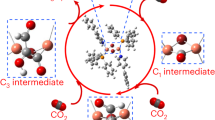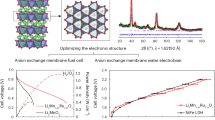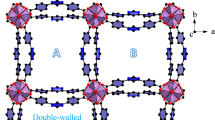Abstract
Cooperative binding, whereby an initial binding event facilitates the uptake of additional substrate molecules, is common in biological systems such as haemoglobin1,2. It was recently shown that porous solids that exhibit cooperative binding have substantial energetic benefits over traditional adsorbents3, but few guidelines currently exist for the design of such materials. In principle, metal–organic frameworks that contain coordinatively unsaturated metal centres could act as both selective4,5,6,7 and cooperative adsorbents if guest binding at one site were to trigger an electronic transformation that subsequently altered the binding properties at neighbouring metal sites8,9,10. Here we illustrate this concept through the selective adsorption of carbon monoxide (CO) in a series of metal–organic frameworks featuring coordinatively unsaturated iron(ii) sites. Functioning via a mechanism by which neighbouring iron(ii) sites undergo a spin-state transition above a threshold CO pressure, these materials exhibit large CO separation capacities with only small changes in temperature. The very low regeneration energies that result may enable more efficient Fischer–Tropsch conversions and extraction of CO from industrial waste feeds, which currently underutilize this versatile carbon synthon11. The electronic basis for the cooperative adsorption demonstrated here could provide a general strategy for designing efficient and selective adsorbents suitable for various separations.
This is a preview of subscription content, access via your institution
Access options
Access Nature and 54 other Nature Portfolio journals
Get Nature+, our best-value online-access subscription
$29.99 / 30 days
cancel any time
Subscribe to this journal
Receive 51 print issues and online access
$199.00 per year
only $3.90 per issue
Buy this article
- Purchase on Springer Link
- Instant access to full article PDF
Prices may be subject to local taxes which are calculated during checkout




Similar content being viewed by others
References
Perutz, M. F. Mechanism of Cooperativity and Allosteric Regulation in Proteins (Cambridge Univ. Press, 1990)
Perrella, M. & Di Cera, E. CO ligation intermediates and the mechanism of hemoglobin cooperativity. J. Biol. Chem. 274, 2605–2608 (1999)
McDonald, T. M. et al. Cooperative insertion of CO2 in diamine-appended metal-organic frameworks. Nature 519, 303–308 (2015)
Caskey, S. R., Wong-Foy, A. G. & Matzger, A. J. Dramatic tuning of carbon dioxide uptake via metal substitution in a coordination polymer with cylindrical pores. J. Am. Chem. Soc. 130, 10870–10871 (2008)
Sumida, K. et al. Carbon dioxide capture in metal–organic frameworks. Chem. Rev. 112, 724–781 (2012)
Herm, Z. R., Bloch, E. D. & Long, J. R. Hydrocarbon separations in metal–organic frameworks. Chem. Mater. 26, 323–338 (2014)
Xiao, D. J. et al. Selective, tunable O2 binding in cobalt(II)–triazolate/pyrazolate metal–organic frameworks. J. Am. Chem. Soc. 138, 7161–7170 (2016)
Kahn, O. & Martinez, C. J. Spin-transition polymers: from molecular materials toward memory devices. Science 279, 44–48 (1998)
Niel, V., Martinez-Agudo, J. M., Munoz, M. C., Gaspar, A. B. & Real, J. A. Cooperative spin crossover behavior in cyanide-bridged Fe(II)–M(II) bimetallic 3D Hofmann-like networks (M = Ni, Pd, Pt). Inorg. Chem. 40, 3838–3839 (2001)
Foucher, D. A., Honeyman, C. H., Nelson, J. M., Tang, B. Z. & Manners, I. Organometallic ferrocenyl polymers displaying tunable cooperative interactions between transition metal centers. Angew. Chem. Int. Edn Engl. 32, 1709–1711 (1993)
Kerry, F. G. Industrial Gas Handbook: Gas Separation and Purification Ch. 8 (CRC, 2007)
Zhou, H. C., Long, J. R. & Yaghi, O. M. Introduction to metal–organic frameworks. Chem. Rev. 112, 673–674 (2012)
Furukawa, H., Cordova, K. E., O’Keeffe, M. & Yaghi, O. M. The chemistry and applications of metal-organic frameworks. Science 341, 1230444 (2013)
Li, J.-R., Kuppler, R. J. & Zhou, H.-C. Selective gas adsorption and separation. Chem. Soc. Rev. 38, 1477–1504 (2009)
Schneemamn, A. et al. Flexible metal–organic frameworks. Chem. Soc. Rev. 43, 6062–6096 (2014)
Serre, C. et al. An explanation for the very large breathing effect of a metal–organic framework during CO2 adsorption. Adv. Mater. 19, 2246–2251 (2007)
Walton, K. S. et al. Understanding inflections and steps in carbon dioxide adsorption isotherms in metal–organic frameworks. J. Am. Chem. Soc. 130, 406–407 (2008)
Benito-Garagorri, D., Lagoja, I., Veiros, L. F. & Kirchner, K. A. Reactivity of coordinatively unsaturated iron complexes towards carbon monoxide: to bind or not to bind? Dalton Trans. 40, 4778–4792 (2011)
Reed, D. A. et al. Reversible CO scavenging via adsorbate-dependent spin state transitions in an iron(II)–triazolate metal–organic framework. J. Am. Chem. Soc. 138, 5594–5602 (2016)
Liao, P.-Q. et al. Drastic enhancement of catalytic activity via post-oxidation of a porous MnII triazolate framework. Chem. Eur. J. 20, 11303–11307 (2014)
Liao, P.-Q. et al. Monodentate hydroxide as a super strong yet reversible active site for CO2 capture from high-humidity flue gas. Energy Environ. Sci. 8, 1011–1016 (2015)
Rieth, A. J., Tulchinsky, Y. & Dinca˘, M. High and reversible ammonia uptake in mesoporous azolate metal–organic frameworks with open Mn, Co, and Ni sites. J. Am. Chem. Soc. 138, 9401–9404 (2016)
Garcia, Y., Niel, V., Munoz, M. C. & Real, J. A. Spin crossover in 1D, 2D, and 3D polymeric Fe(II) networks. Top. Curr. Chem. 233, 229–257 (2004)
Bloch, E. D. et al. Reversible CO binding enables tunable CO/H2 and CO/N2 separations in metal-organic frameworks with exposed divalent metal cations. J. Am. Chem. Soc. 136, 10752–10761 (2014)
International Energy Agency. Global Action to Advance Carbon Capture and Storage: A Focus on Industrial Applications http://www.iea.org/publications/freepublications/publication/CCS_Annex.pdf (IEA, 2013)
Dutta, N. N. & Patil, G. S. Developments in CO separation. Gas. Sep. Purif. 9, 277–283 (1995)
Sato, H. et al. Self-accelerating CO sorption in a soft nanoporous crystal. Science 343, 167–170 (2014)
Peng, J. et al. A supported Cu(I)@MIL-100(Fe) adsorbent with high CO adsorption capacity and CO/N2 selectivity. Chem. Eng. J. 270, 282–289 (2015)
Davis, R. A., Nicholas, D. M., Smith, D. D., Wang, S.-I. & Wright, R. A. Integrated reformer process for the production of carbon black. US patent 5,011,670 (1991)
Halder, G. J., Kepert, C. J., Moubaraki, B., Murray, K. S. & Cashion, J. D. Guest-dependent spin crossover in a nanoporous molecular framework material. Science 298, 1762–1765 (2002)
Denysenko, D. et al. Elucidating gating effects for hydrogen sorption in MFU-4-type triazolate-based metal–organic frameworks featuring different pore sizes. Chem. Eur. J. 17, 1837–1848 (2011)
Coelho, A. A. Indexing of powder diffraction patterns by iterative use of singular value decomposition. J. Appl. Cryst. 36, 86–95 (2003)
Coelho, A. A. TOPAS-Academic, version 4.1 (Coelho Software, 2007)
Acknowledgements
This research was supported through the Center for Gas Separations Relevant to Clean Energy Technologies, an Energy Frontier Research Center funded by the US Department of Energy, Office of Science, Office of Basic Energy Sciences under award DE-SC0001015. Powder X-ray diffraction data were collected at Beamline 11-BM and Beamline 17-BM at the Advanced Photon Source, a DOE Office of Science User Facility, operated by Argonne National Laboratory under contract DE-AC02-06CH11357. We thank P. C. Bunting, R. L. Siegelman and J. E. Bachman for discussions, and H. Z. H. Jiang for experimental assistance. D.A.R., J.O., J.A.M., D.J.X. and L.E.D. thank the National Science Foundation for graduate fellowship support.
Author information
Authors and Affiliations
Contributions
D.A.R., B.K.K. and J.R.L. formulated the project. D.A.R. and B.K.K. synthesized the compounds. D.A.R. and B.K.K. collected and analysed the gas adsorption data. J.O., J.A.M. and T.R. collected and analysed the X-ray diffraction data. D.J.X. collected and analysed the Mössbauer spectra. L.E.D. collected and analysed the magnetic susceptibility data. V.C. and S.B. collected and analysed the infrared spectra. D.A.R., B.K.K. and J.R.L. wrote the paper, and all authors contributed to revising it.
Corresponding author
Ethics declarations
Competing interests
J.R.L., D.A.R., B.K.K. and the University of California, Berkeley have filed for a patent on some of the results contained herein.
Additional information
Publisher's note: Springer Nature remains neutral with regard to jurisdictional claims in published maps and institutional affiliations.
Supplementary information
Supplementary Information
This file contains supplementary discussion, tables S1-S10 and figures S1-S21. (PDF 3088 kb)
Rights and permissions
About this article
Cite this article
Reed, D., Keitz, B., Oktawiec, J. et al. A spin transition mechanism for cooperative adsorption in metal–organic frameworks. Nature 550, 96–100 (2017). https://doi.org/10.1038/nature23674
Received:
Accepted:
Published:
Issue Date:
DOI: https://doi.org/10.1038/nature23674
This article is cited by
-
Quasi-open Cu(i) sites for efficient CO separation with high O2/H2O tolerance
Nature Materials (2024)
-
An electron-transfer [Fe2Co2] square complex exhibiting unprecedented wide room-temperature hysteresis
Science China Chemistry (2024)
-
A ligand insertion mechanism for cooperative NH3 capture in metal–organic frameworks
Nature (2023)
-
A spin-crossover framework endowed with pore-adjustable behavior by slow structural dynamics
Nature Communications (2022)
-
Reconstructed covalent organic frameworks
Nature (2022)
Comments
By submitting a comment you agree to abide by our Terms and Community Guidelines. If you find something abusive or that does not comply with our terms or guidelines please flag it as inappropriate.



